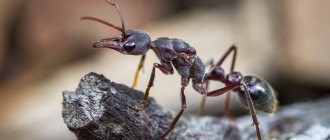Formation of safe behavior skills in children of senior preschool age (training)
Voronkina M.Yu., Poluektova V.I., Rostovshchikova N.P. Formation of safe behavior skills in children of senior preschool age (training) // Sovushka. 2022. N1 (15). URL: https://kssovushka.ru/zhurnal/15/ (access date: 02/05/2022).
Order No. 272014
Abstract: The article is devoted to practical issues of developing safe behavior skills in children of senior preschool age. A training plan for “Stranger” is provided.
Key words: safety, preschool age, game exercises, modeling, training.
In accordance with the Federal State Educational Standard, preschool education is being modernized in preschool educational institutions. In this regard, new goals, objectives and directions for the preschool educational institution are being determined.
One of the important areas of work is developing children’s safe life skills and the ability to build safe behavior in the world around them.
From the first years of life, a child’s curiosity, his activity in matters of knowledge of the environment, encouraged by adults, sometimes becomes unsafe for him. The formation of safe behavior is inevitably associated with a number of prohibitions. At the same time, adults who love and care for their children sometimes do not notice how often they repeat the words: “don’t touch,” “move away,” “no.” Or, on the contrary, they try to explain something through long instructions that are not always understandable to children. All this gives the opposite result.
Life safety is one of the main problems of humanity. Environmental disasters, terrorist attacks, military conflicts, increased crime, social and economic instability have a particularly acute impact on children. Every person, both adults and children, can find themselves in an emergency situation at any moment. How to protect children's health? How can I help you understand the variety of life situations? How to teach to help each other? Analyzing the concept of “extreme” and “safety”, we will understand: what is not a problem situation for an adult can become one for a child. We feel special concern for small defenseless citizens – preschool children. Such characteristics of a preschooler as gullibility, suggestibility, openness in communication and curiosity determine behavior in a dangerous situation and contribute to his vulnerability. Preschool children often lack readiness for self-preservation and have a poorly developed ability to analyze the situation and predict the consequences of their actions. There is a need to protect children from dangers, without suppressing their natural curiosity, openness and trust in the world, without frightening them and preparing them for a full life. A child’s independence is relative, his well-being and his very life depend on the attention and help of the adults raising him. Without an adult, a child cannot survive and develop into a social personality.
Almost every day we are faced with people violating safety rules - some due to ignorance, and others due to their own carelessness. Therefore, forming the foundations of safe behavior in children is everyday, difficult and necessary work.
The period of preschool childhood in children is characterized by an increase in motor activity and an increase in the child’s physical capabilities, which, combined with increased curiosity and the desire for independence, often lead to the occurrence of traumatic situations.
Play is the main activity of children, in which character is developed, ideas about the environment are expanded, motor skills, precision of movements, attentiveness, concentration are formed and improved, those qualities that are so necessary to prevent dangers. Children play without suspecting that they are mastering some knowledge, mastering the skills of operating with certain objects, and learning a culture of communication with each other.
A more effective and modern method of teaching safe behavior skills is the modeling method, which contains in its structure a triad of components that provide valuable pedagogical properties: play, imitation and analysis of a specific situation.
The peculiarity of this method is that it is a link between the content of knowledge about safety rules and the organization of activities for their application. It is important to take into account the special conditions for implementing the method of modeling game situations:
- Using a mock-up setting or a specially designed object-play environment in a group room;
- Preliminary acting out of situations by the teacher (showing puppet shows) with the gradual involvement of children;
- Introduction of activity motivation that is meaningful for preschoolers;
- “appearance” of obstacles or special conditions during gaming activities;
- Maintaining an adequate emotional background.
Having learned to act correctly in simulated game situations that closely replicate the real situation, preschoolers will feel much more confident in real conditions. The essence of the game situation is that children are placed in conditions that are close to reality. In order to prevent children's fears, “information neurosis” due to the expansion and deepening of knowledge about dangerous situations, each lesson should be completed positively. At the same time, training should not be turned into a fun game - children should take this activity seriously.
Game exercises and simulation of situations using layouts of a group, room, vehicles, city street. The use of these types of practical methods helps to develop a cautious and prudent attitude towards potentially dangerous situations for humans in everyday life, on the street, in nature.
The holding of trainings. Trainings are a group form of interaction between an adult (usually a psychologist) and children, which makes it possible to relieve children of the feeling of the uniqueness of their problems and difficulties, aimed at uniting preschoolers in the group, creating a sense of community among all training participants. Trainings help students build relationships with other people without provoking conflict situations.
Safe behavior training helps children update their knowledge about safety and possible sources of danger; acquire skills of safe behavior in critical situations; create a culture of safe behavior in society.
Training “Stranger”.
Goal: to develop children’s skills of safe behavior in situations of communication with strangers.
Tasks:
- Clarify children's knowledge about the rules of behavior with strangers.
- Bring children to the ability to assess their capabilities to overcome danger and the ability to choose methods of action in accordance with this.
- Clarify knowledge about the need to seek help from adults in the event of a life-threatening situation.
1. Game "Familiar, friend, stranger."
Goal: to clarify children’s ideas about who is a safe communication partner for them.
Children stand at a short distance from each other, forming a circle. The driver (adult) is in the center and alternately throws the ball to each child, saying “Familiar, friend, stranger,” highlighting with intonation and pause the one who needs to be named. The child who catches the ball names the appropriate person and returns the ball to the driver.
The pace of throwing the ball can speed up or slow down. The game ends when all children complete the task without errors.
2. Game "So, but not so."
Goal: clarifying knowledge of the rules of safe behavior.
The presenter reads the situations to the children, and the children hold up cards with the appropriate sign: a dangerous situation is an exclamation mark, a non-dangerous situation is a smiley face.
Example situations:
- Stay anywhere all the time close to friends, with people.
- Get into a car with a stranger if he invites you for a ride.
- Immediately move away from the edge of the sidewalk if a car slows down next to you or if it is driving slowly behind you. No matter what the driver says, you need to stay away from the car.
- Go with an unfamiliar adult if he promises to give a toy, candy or show something interesting, introducing himself as an acquaintance of his parents or informing him that he is acting at their request.
- If an unfamiliar adult grabs you by the hand, picks you up, drags you into a car, pushes you into an entrance or some building, you need to shout loudly, calling for help and attracting the attention of others: “Help, help, stranger!”
- Participate in games with older children when they call to see what is happening at the construction site; light a fire; climb into the attic of the house and climb out onto the roof; go down to the basement; play in the elevator; “experiment” with medicines and odorous substances; climb a tree;
- Do not enter the entrance alone, without parents or familiar adults.
- Do not open the door to a stranger, even if the stranger has a gentle voice or introduces himself as someone familiar to his parents and knows their name.
- Ride on public transport without adults.
- Do not show money to attract attention.
- Approach close to the edge of the road at a bus stop, especially during icy periods.
- If a child is lost on the street, you should turn to some adult for help (for example, a policeman, a security guard, a woman walking with a child, a salesperson at a pharmacy, a cashier at a savings bank) and say that he is lost, give his address and number phone number, your first and last name.
- Use the telephone in case of a fire (call the fire department at number 01), in case of injury (call an ambulance 03).
3. Game "Rooster and Fox".
Goal: formation of rules of behavior in a kidnapping situation.
Recall with the children how in the fairy tale the cockerel calls his friends for help when he is kidnapped by a fox. Remind that in such a situation, you need to shout very loudly. Invite the children, if desired, to act out a scene from a fairy tale. During the discussion, convey to the children the information: “What should they do if they are kidnapped.”
4. Game "Kidnappers and resourceful guys."
Purpose: practicing actions during an attempted kidnapping.
The children are divided into two teams: the kidnappers and the resourceful guys. The kidnappers are trying in a variety of ways to take the guys over the line (pulling, dragging, dragging), and the guys are trying to resist them (screaming, breaking free, falling). The rule is that you cannot bite or fight in this game. The kidnappers are given a certain time to complete the task, for example 2 minutes. Then the teams change roles.
5. Quiz "Careless heroes of fairy tales."
Goal: the ability to assess the safety of the actions of others and provide assistance in a dangerous situation.
Questions:
- What safety rule did Little Red Riding Hood break?
- What trick did the wolf come up with in the fairy tale “The Wolf and the Seven Little Goats” in order to get into the goat’s house?
- Why did the Cockerel always fall into the clutches of the fox in the fairy tale “The Cat, the Rooster and the Fox?”
- What rule of safe behavior did the bun break?
- Why in the fairy tale “Zayushkina’s Hut” the hare was left homeless?
- In which fairy tales did the heroes manage to outwit and defeat the treacherous villains? (Tom Thumb, Puss in Boots, Masha and the Bear, Three Bears, Three Little Pigs).
6. Outdoor game "Tea - tea, help out."
Goal: development of mutual assistance skills.
Literature:
- Anastasova L.P. Life without danger. M.: Vintana-Graf. 1996.
- Vasilyeva I. Teaching safety rules // Preschool education. 1990. No. 2.
- Vasyukova N.E., Rodina N.M. Comprehensive thematic planning of the educational process. 2012. P. 104.
- Golitsina N.S. Life safety for older preschoolers. M., 2011.
- Grizik T.I., Glushkova G.V. Formation of the foundations of safe behavior in children 3-8 years old. M.: Education, 2015. 96 p.
- Kolomeets N.V. Formation of a culture of safe behavior. Volgograd: Teacher, 2011. P. 83.
- Maksimchuk L.V. What preschoolers should know about safety. M.: 2008. 39 p.
- Santaeva T.S. Safety of children and adults // Preschool educational institution management. 2004. No. 3.
- Fundamentals of safe behavior for preschoolers: classes, planning, recommendations / Chermashentseva O.V. Volgograd: Teacher, 2010. P. 64.






